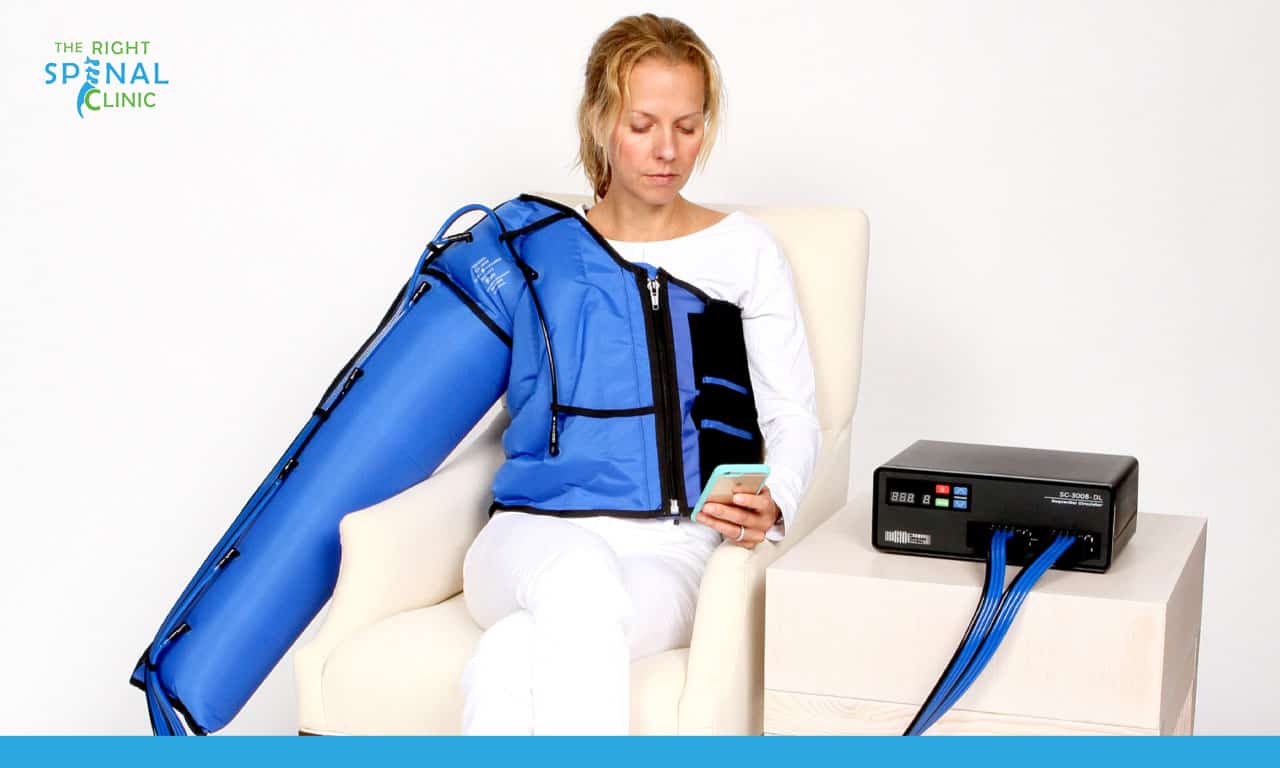
At The Right Spinal Clinic, we are committed to providing our patients with the most advanced and effective treatment methods available in physical therapy. One of the innovative techniques we offer is iontophoresis, a cutting-edge approach to delivering medication directly into the target injured tissues. In this blog post, we'll explore what iontophoresis is, how it works, and the many benefits it can provide in your physical therapy treatment plan.
What is Iontophoresis?
Iontophoresis is a technique that helps deliver medication directly through the skin using a mild electrical current. This method involves placing a drug, which is typically in a solution or gel form, onto the skin. Small electrodes are then attached to the area. When the device is turned on, the electrical current gently pushes the medication through the skin and into the tissues beneath.
This process is particularly useful for treating conditions like muscle and joint injuries, swelling (edema), and various types of pain. Because the medicine is delivered right where it's needed, it can be more effective and faster acting than taking it orally. It's also beneficial because it reduces the likelihood of systemic side effects, making it a preferred choice for localized treatment.
The Science Behind Iontophoresis
Iontophoresis works by taking advantage of the principles of electromotive drug administration. The process involves placing two electrodes (one positive and one negative) on the skin, with the desired medication being loaded into one of the electrodes. In some cases the medication is positively charged and in others, the medication is negatively charged. Depending on the charge, the medication is driven through the tissue from the negative side to the positive side of the delivery node, and vice versa for a positively charged medication. The reverse is true if the medication is positively charted, it will move through the targeted area Some medications are positively or negatively charged When a gentle electrical current is applied, it causes the charged molecules of the medication to be repelled from the like-charged electrode and pushed through the skin, driving the
Commonly used medications in iontophoresis include dexamethasone iontophoresis (a corticosteroid for reducing inflammation), lidocaine iontophoresis (a local anesthetic for pain relief), and acetic acid (for managing scar tissue and calcium deposits). The polarity of the applied current determines which electrode the positively charged or negatively charged drugs are loaded into, ensuring that the medication is effectively driven into the target area.
Benefits of Iontophoresis in Physical Therapy
At The Right Spinal Clinic, we have seen numerous benefits of incorporating iontophoresis into our physical therapy treatment plans, including:
Targeted Medication Delivery
Oral medications circulate throughout the body and topically applied medications can only penetrate so far into the skin. Iontophoresis is used to directly administer mediation deep within the injured tissues, maximizing the therapeutic effect and minimizing potential side effects. This targeted approach helps avoid adverse skin reactions that can sometimes occur with oral and topical application medications.
Non-Invasive
Iontophoresis is a completely non-invasive procedure, eliminating the need for injections or other invasive drug delivery methods. This makes it a safer and more comfortable option for many patients.
Improved Absorption
Physical therapists use electrical stimulation and iontophoretic transport to enhance medication absorption through the skin and into the underlying tissues, achieving optimal therapeutic levels with less medication. This improved absorption surpasses the limitations of applying a topical medication or taking oral medications.
Reduced Inflammation and Pain
Many of our patients have experienced significant reductions in inflammation, pain, and muscle spasms after using iontophoresis treatments. This is especially true of patients who also used other physical therapy modalities. This effect is attributed to the medication directly targeting inflamed and painful tissues.
Faster Recovery
By effectively delivering medication to the injured area and reducing inflammation, iontophoresis can help accelerate the healing process and promote a quicker return to normal activity levels. This faster recovery allows patients to actively participate in their rehabilitation and regain their full potential sooner.
Iontophoresis Treatment Process at The Right Spinal Clinic
At The Right Spinal Clinic, our experienced physical therapists follow a meticulous protocol when administering iontophoresis treatments:
Initial Evaluation
Your initial evaluation will be a thorough examination by our physical therapists to assess your condition, medical history, and treatment goals to see if iontophoresis is a suitable treatment option. This evaluation helps ensure the best possible outcomes and avoids potential contraindications - or complications that can arise due to underlying health concerns.
Treatment Preparation
If iontophoresis is right for you, your physical therapist will provide specific instructions on preparing for the treatment, including any necessary precautions or situations where iontophoresis might not be recommended.
Electrode Placement
During the treatment session, your physical therapist will apply the iontophoresis electrodes to the target area. The medication, typically an analgesic or anti-inflammatory drug, will be loaded into the "active electrode" based on the principle of "likes repel." This ensures optimal drug delivery and minimizes the risk of skin damage.
Electrical Current Application
A mild electric field will then be applied through the iontophoresis system. This current acts as the driving force, causing the charged medication molecules to be transported across the skin's natural barrier, administering medication directly into the underlying tissues. This process is known as a non-invasive transdermal drug delivery via iontophoresis, offering a more targeted and effective approach when compared to taking medications by mouth or applying them to the skin.
Monitoring and Adjustments
Throughout the treatment, your physical therapist will closely monitor your response and make any necessary adjustments to the electrical current density or treatment parameters. This ensures optimal medication delivery and patient comfort.
Post-Treatment Care
After the treatment, your physical therapist will guide you in aftercare, such as applying a barrier cream or withholding ice or heat treatments for a short period. This helps optimize the effect of iontophoresis and minimize any potential side effects.
At The Right Spinal Clinic, we prioritize patient safety and utilize state-of-the-art iontophoresis equipment. We adhere to strict safety protocols to ensure a safe and effective treatment experience.

Comparing Iontophoresis to Other Treatment Options
While there are various treatment options available in physical therapy, the clinical use of iontophoresis offers several unique advantages. Unlike passive treatments, such as hot or cold packs, iontophoresis actively introduces medication into the injured tissues, providing a more targeted and potentially more effective approach.
Compared to oral medication or injections, iontophoresis minimizes systemic absorption and potential side effects by delivering the medication directly to the affected area. Additionally, iontophoresis is a non-invasive procedure, eliminating the discomfort and risks associated with injections or other invasive methods.
While other transdermal drug delivery systems, such as patches or creams, can be effective, they often rely on passive absorption, which may result in inconsistent or suboptimal medication delivery. Iontophoresis, on the other hand, actively pushes the medication through the human skin, ensuring more reliable and efficient drug administration.
How to Get Started with Iontophoresis at The Right Spinal Clinic
If you're interested in exploring iontophoresis as part of your physical therapy treatment plan, the first step is to schedule a consultation with one of our experienced physical therapists at The Right Spinal Clinic. During this initial visit, your physical therapist will conduct a comprehensive evaluation to determine if iontophoresis is an appropriate treatment option for your specific condition.
If iontophoresis is recommended, your physical therapist will provide you with detailed instructions on how to prepare for the treatment, as well as what to expect during and after the procedure. Our team will work closely with you to ensure a safe, comfortable, and effective iontophoresis experience.
The Right Spinal Clinic Can Help
At The Right Spinal Clinic in Tampa, we understand that finding the right treatment for your condition can be challenging. That's why we've made it our mission to stay at the forefront of the latest advancements in physical therapy, including innovative techniques like iontophoresis. Our team of highly skilled and experienced physical therapists is dedicated to providing personalized, comprehensive care tailored to your unique needs and goals.
If you're suffering from inflammation, pain, or other musculoskeletal conditions, we encourage you to explore the potential benefits of iontophoresis. Our experts will work closely with you to determine if this cutting-edge treatment is right for you and develop a customized plan to help you achieve optimal recovery and long-lasting relief. Don't let your condition hold you back any longer – take the first step towards a better quality of life by calling us today at (813) 582-7000 and scheduling your consultation.
FAQs
What types of conditions can Iontophoresis treat?
Iontophoresis can be used to treat various musculoskeletal conditions, including inflammation, edema, pain management, and scar tissue or calcium deposit management. It is particularly effective for conditions like plantar fasciitis, carpal tunnel syndrome, and other injuries or conditions that involve localized inflammation or pain.
Is Iontophoresis painful?
No, iontophoresis is generally not a painful procedure. Most patients report only a mild tingling sensation during the treatment as the electric current is applied. Your physical therapist will monitor your comfort levels throughout the treatment and make any necessary adjustments to ensure a comfortable experience.
How long does an Iontophoresis session last?
The duration of an iontophoresis session can vary depending on the specific condition being treated and the treatment protocol prescribed by your physical therapist. Typically, a single session can range from 10 to 30 minutes, and multiple sessions may be recommended for optimal results.
At The Right Spinal Clinic, we are dedicated to providing our patients with the highest quality physical therapy services, utilizing the latest and most effective treatment methods available. If you're interested in learning more about iontophoresis or scheduling an appointment, please don't hesitate to contact us today.
Recent Posts










